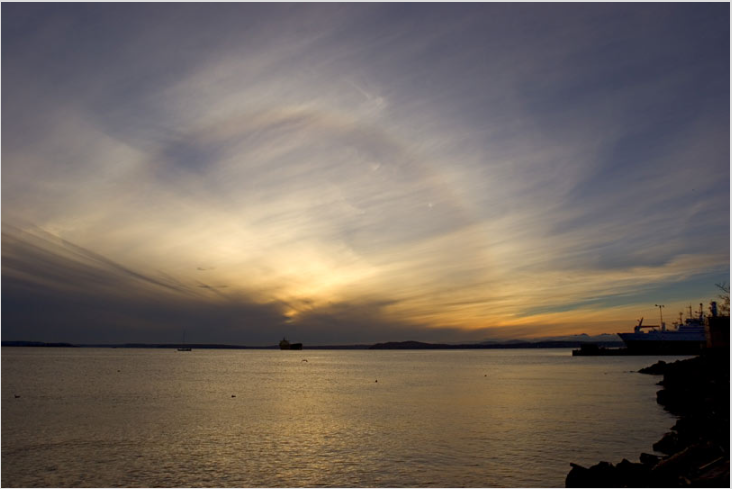22 degree halo Puget Sound Washington States
The Phenomenon of the 22 Degree Halo in Puget Sound, Washington State
The 22 degree halo is a captivating atmospheric optical phenomenon that can be observed in various parts of the world, including Puget Sound, Washington State. This natural spectacle occurs when light interacts with ice crystals in the atmosphere, resulting in a halo-like ring around the sun or moon. While the existing content provides a brief overview, let's delve deeper into the intricacies of this fascinating phenomenon.
How Does the 22 Degree Halo Form?
The formation of the 22 degree halo begins with the presence of high-altitude cirrus clouds containing an abundance of ice crystals. These tiny hexagonal ice crystals act as prisms, bending and refracting light as it passes through them. When sunlight or moonlight encounters these ice crystals at a specific angle, it undergoes refraction and is deflected by approximately 22 degrees. This deflected light creates a circular halo with a radius of 22 degrees around the celestial body.
Factors Affecting Halo Appearance
Several factors influence the appearance of the 22 degree halo in Puget Sound, Washington State, and other locations. These factors include:
-
Crystal Size: The size of the ice crystals plays a crucial role in determining the halo's characteristics. Smaller crystals produce a more pronounced and vibrant halo, while larger crystals may lead to a fainter or less defined halo.
-
Crystal Orientation: The orientation of the ice crystals as they fall through the atmosphere affects the shape and intensity of the halo. When the crystals align themselves horizontally, they tend to create a more distinct halo.
-
Atmospheric Conditions: The atmospheric conditions, such as humidity and temperature, influence the formation and visibility of halos. In Puget Sound, where weather patterns can vary greatly, these conditions can contribute to the appearance or disappearance of halos.
Variations of the 22 Degree Halo
While the 22 degree halo is the most commonly observed halo, there are variations and additional halos that can occur simultaneously or independently. Some of these include:
-
Supralateral Arc: This arc forms at a higher angle than the 22 degree halo and appears as an extension of the halo, curving upwards.
-
Circumzenithal Arc: Often referred to as an "upside-down rainbow," this arc appears as an arc of colors above the sun or moon. It is caused by sunlight refracting through horizontally oriented ice crystals.
-
Upper Tangent Arc: This faint arc occurs above the 22 degree halo and connects with the circumzenithal arc, creating a triangular shape.
Capturing the Beauty of the 22 Degree Halo
Photographing the 22 degree halo can be a rewarding experience for enthusiasts and photographers alike. To capture its beauty, consider the following tips:
-
Location: Choose a location with an unobstructed view of the sky, preferably away from light pollution, to maximize visibility.
-
Timing: The best time to observe and photograph halos is during sunrise or sunset when the angle of the sun is lower in the sky. This angle enhances the visibility and intensity of the halo.
-
Camera Settings: Experiment with different camera settings to capture the halo's details. Adjusting exposure, ISO, and aperture can help bring out the halo's colors and intricacies.
-
Composition: Incorporate interesting foreground elements to add depth and context to your halo photographs. Consider including landscapes, trees, or architectural features to create visually appealing compositions.
The Magic of Atmospheric Optics
The 22 degree halo in Puget Sound, Washington State, exemplifies the captivating beauty of atmospheric optics. This natural phenomenon reminds us of the intricate interplay between light and ice crystals high above us. By understanding its formation and variations, we can appreciate the awe-inspiring displays that nature presents in the sky. So, next time you find yourself gazing at the sun or moon in Puget Sound, keep an eye out for the enchanting 22 degree halo and its mesmerizing companions.

Sunset halo over Puget Sound, Washington State. Taken from Seattle by David Kugler 11th December '04. The diffuse inner edge and broadening could be caused by diffraction effects from very small ice crystals. Image ©2004 David Kugler, shown with permission.
Note: this article has been automatically converted from the old site and may not appear as intended. You can find the original article here.
Reference Atmospheric Optics
If you use any of the definitions, information, or data presented on Atmospheric Optics, please copy the link or reference below to properly credit us as the reference source. Thank you!
-
<a href="https://atoptics.co.uk/blog/22-degree-halo-puget-sound-washington-states/">22 degree halo Puget Sound Washington States</a>
-
"22 degree halo Puget Sound Washington States". Atmospheric Optics. Accessed on December 2, 2024. https://atoptics.co.uk/blog/22-degree-halo-puget-sound-washington-states/.
-
"22 degree halo Puget Sound Washington States". Atmospheric Optics, https://atoptics.co.uk/blog/22-degree-halo-puget-sound-washington-states/. Accessed 2 December, 2024
-
22 degree halo Puget Sound Washington States. Atmospheric Optics. Retrieved from https://atoptics.co.uk/blog/22-degree-halo-puget-sound-washington-states/.